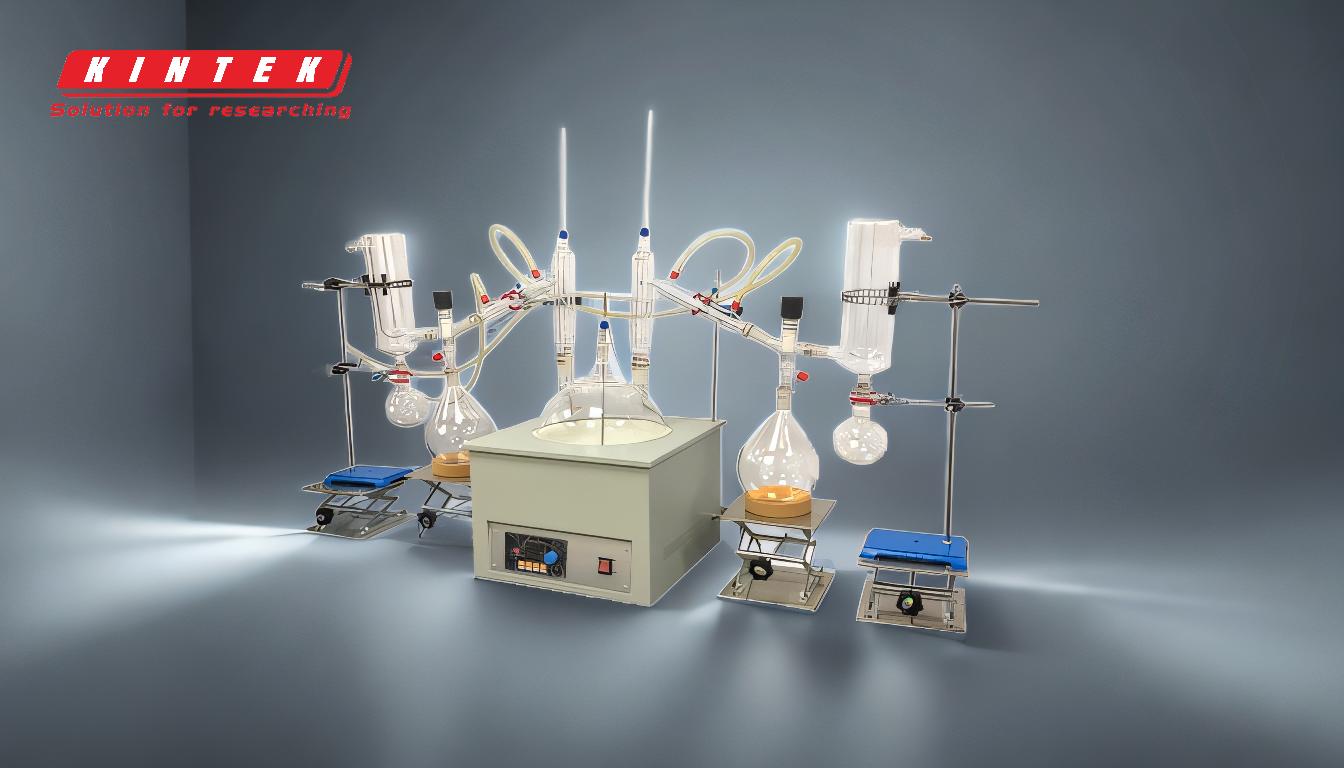Short path distillation, also known as molecular distillation, is a specialized thermal separation process designed for heat-sensitive materials. It operates under high vacuum conditions, allowing for lower boiling temperatures and minimizing thermal stress on the product. The process involves heating a liquid mixture in a flask, with the vapor traveling a short distance to a condenser, where it is cooled and collected. This method is highly efficient for separating components with different boiling points, such as terpenes, THC, and CBD in essential oils, and is widely used in industries like medicine, petroleum, and food. The key advantages include gentle processing, high purity of the final product, and minimal thermal degradation.
Key Points Explained:

-
Definition and Purpose:
- Short path distillation is a thermal separation process used to purify or separate components of a liquid mixture based on their boiling points.
- It is particularly effective for heat-sensitive materials, as it operates under high vacuum conditions, reducing the boiling temperatures and minimizing thermal stress.
-
Operating Conditions:
- The process operates under a vacuum level of 0.001 to 1 mbar, which significantly lowers the boiling points of the components.
- This allows for the separation of compounds that would otherwise degrade at higher temperatures.
-
Equipment and Setup:
- The setup typically includes a boiling flask, a short-path distillation head, a condenser, and a collection flask.
- A heating mantle is used to heat the substance, and a vacuum pump is applied to create the necessary vacuum conditions.
- The condenser is cooled by a recirculating chiller to condense the vapor back into liquid form.
-
Process Mechanism:
- The liquid mixture is heated in the boiling flask, and the vapor travels a short distance to the condenser.
- The short distance minimizes the residence time of the vapor, reducing the risk of thermal degradation.
- The condensed vapor is collected in the receiving flask, with different fractions being isolated as the temperature increases.
-
Applications:
- Essential Oils: Used to separate and purify terpenes, THC, and CBD from cannabis or other plant extracts.
- Pharmaceuticals: Ideal for purifying heat-sensitive compounds in drug manufacturing.
- Food Industry: Used in the extraction and purification of flavors and fragrances.
- Petroleum: Applied in the refining of oils and other petroleum products.
-
Advantages:
- Gentle Processing: The low temperatures and short residence time protect heat-sensitive compounds from degradation.
- High Purity: The process results in a highly pure final product, with minimal contamination from unwanted compounds.
- Efficiency: The large surface area for evaporation and condensation makes the process highly efficient.
-
Considerations for Equipment and Consumable Purchasers:
- Vacuum Pump: Ensure the vacuum pump can achieve and maintain the required vacuum levels (0.001 to 1 mbar).
- Heating Mantle: Choose a heating mantle that provides precise temperature control to avoid overheating sensitive materials.
- Condenser: Opt for a condenser with efficient cooling capabilities, possibly using a recirculating chiller for consistent temperature control.
- Glassware: High-quality, durable glassware is essential to withstand the vacuum and temperature conditions.
- Safety: Ensure all equipment is compatible with the chemicals being processed and that safety protocols are in place for handling high vacuum and heat.
By understanding these key points, equipment and consumable purchasers can make informed decisions to optimize the short path distillation process for their specific applications.
Summary Table:
| Key Aspect | Details |
|---|---|
| Purpose | Purifies or separates components based on boiling points, ideal for heat-sensitive materials. |
| Operating Conditions | Operates under 0.001 to 1 mbar vacuum, reducing boiling points and thermal stress. |
| Equipment | Boiling flask, distillation head, condenser, collection flask, vacuum pump, heating mantle. |
| Applications | Essential oils (terpenes, THC, CBD), pharmaceuticals, food industry, petroleum refining. |
| Advantages | Gentle processing, high purity, minimal thermal degradation, high efficiency. |
| Purchasing Considerations | Vacuum pump, heating mantle, condenser, glassware, and safety protocols. |
Optimize your short path distillation process—contact our experts today for tailored solutions!










